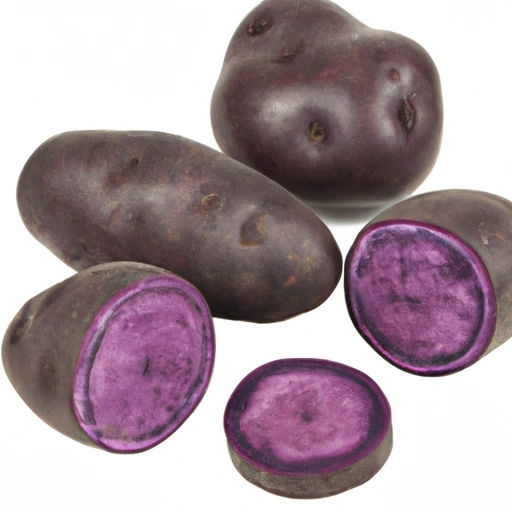Purple Potato
Description

The purple potato is a vibrant and visually striking tuber that belongs to the Solanum family. Revered for its deep purple to almost black skin and flesh, this potato variant is not only a feast for the eyes but also loaded with nutritious benefits and a unique flavor profile. Purple potatoes are available in various shapes and sizes, ranging from small, new potatoes to larger specimens perfect for a myriad of culinary applications.
Common uses
Purple potatoes are enjoyed in a variety of dishes, from simple roasted wedges to sophisticated culinary creations. They can be used in any recipe that calls for potatoes, adding a pop of color and a slight nutty flavor that distinguishes them from their yellow or red counterparts.
Nutritional value
Calories
A 100-gram serving of purple potatoes contains approximately 70 calories (293 kilojoules).
Protein
Each serving provides about 2 grams of protein.
Fat
Purple potatoes are naturally low in fat, with around 0.1 grams per serving.
Carbohydrates
With 15 grams of carbohydrates per serving, they are a healthy source of energy.
Vitamins
They are a good source of vitamin C and B-complex vitamins.
Minerals
Rich in potassium, the purple potato also offers magnesium, iron, and calcium.
Health benefits
Purple potatoes are known for their antioxidant properties, largely due to the presence of anthocyanins. They may help reduce inflammation and are linked to a lower risk of heart disease and certain cancers. Their high potassium content also helps regulate blood pressure.
Potential risks
As with any food, moderation is key. Purple potatoes are high in carbohydrates, which should be consumed thoughtfully, especially by individuals managing blood sugar levels. The natural presence of solanine, a compound found in nightshades, can be a concern for those with sensitivities, though it is generally safe for the majority of people when the potatoes are properly cooked.
Common recipes
Purple potatoes can be featured in recipes ranging from mashed potatoes to potato salads, soups, and gratins. They can also be baked, grilled, or pureed for a visually stunning side dish.
Cooking methods
These potatoes can be boiled, steamed, roasted, sautéed, or fried. Their firmer texture holds up well to various cooking methods, making them versatile for different culinary techniques.
Pairing with other ingredients
Their earthy flavor pairs well with herbs like rosemary and thyme, spices such as paprika and cumin, and proteins like chicken, beef, and fish. They also complement creamy sauces and cheeses.
Summary
Purple potatoes are a nutritious and eye-catching ingredient that can liven up any dish with their color and flavor. They are rich in antioxidants and beneficial nutrients, and can be prepared in countless ways to suit a variety of cuisines and dietary preferences. Whether roasted for a simple side or incorporated into a complex entree, purple potatoes are sure to impress both visually and nutritionally.